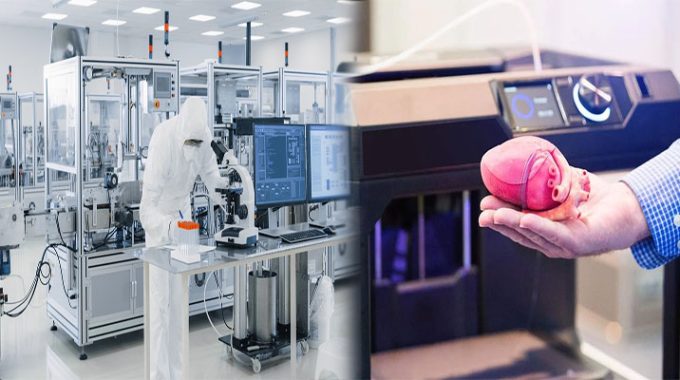In the past few years, 3D printing has emerged as a promising tool in the medical industry. The technology is allowing doctors to create complex implants and prostheses with ease and precision. In addition, 3D printing can help save lives by providing patients with new organs when they are needed most.
3D printing has become popular in the medical and biotechnology industries.
3D printing is a process that builds up a three-dimensional object from layers of material. 3D printers can be used to make prototypes and models, customized prosthetics, orthotics and implants.
3D printing has become popular in the medical and biotechnology industries because it allows professionals to create personalized devices quickly and easily. This can help patients who have lost limbs due to injury or disease regain their mobility while reducing costs compared with traditional manufacturing methods such as molding plastics or casting metal parts out of molds made from waxes
Artificial bones
3D printing is being used to create artificial bones.
- [3D printed bone grafts are being used to help patients heal after surgery](https://www.medicalnewstoday.com/articles/321029.php).
- [Researchers have created 3D-printed bones that can be implanted into animals and humans, offering a promising alternative to traditional methods of bone replacement and repair](https://www.sciencedaily.com/releases/2017/07/170709083351.htm).
Heart valves
In the world of 3D printing, heart valves are a prime example of how a new technology can help make your life better. A heart valve is a mechanical device that controls the flow of blood between the chambers of your heart. If you’re born with abnormal or damaged valves, it can be very dangerous to your health–and there’s no way to replace them surgically.
However! With 3D printing technology at their disposal, researchers have been able to create replacement valves that are customized for each patient and printed directly onto their bodies with biocompatible materials like titanium and stainless steel oxide (aka “metal powder”). These new devices don’t need replacing like traditional transplants do; instead they are built from scratch as needed throughout one’s lifetime–an incredible feat considering how delicate these tiny organs are!
Implants for replacement of damaged parts of human bones, such as femurs, scapulae, and mandibles.
3D printing can be used to make artificial bones. There are two main types of 3D-printed implants for replacement of damaged parts of human bones: bone substitutes and bone grafts.
- Bone substitutes are made from materials that mimic the properties of natural bone, such as hydroxyapatite (HA), tricalcium phosphate (TCP) or other biocompatible ceramics. These materials are mixed with water or saline solution and then extruded into their desired shape using a printer nozzle.[1] The resulting structure is porous and acts as scaffolding for new tissue growth while providing structural support.[2]
- Biodegradable scaffolds made from polymers like polylactic acid (PLA), polyglycolic acid (PGA) or polycaprolactone may also be used as an alternative to metal implants.[3]
Bionic hands and arms
Bionic hands and arms are 3D printed. They can be bought online and shipped to your door, and they’re made possible by the same technology that allows you to print your own replacement parts at home.
Bionic limbs are a prime example of how 3D printing is revolutionizing medicine. In many cases, they’re superior to traditional prosthetics because they’re lighter, more durable and less expensive than other options on the market today–and they look cooler too!
But why use 3D printing in this way? Why not just cast new parts from molds or make them by hand like doctors did before? Well for one thing: time constraints! If someone needs surgery immediately after losing an arm (or whatever), there isn’t much time for anything else besides getting them back up on their feet again as soon as possible; so having access via technology like this is invaluable when it comes down to saving lives versus spending extra time designing something new from scratch just because it might look better aesthetically speaking…
Hearing aids
3D printing is used to create hearing aids. The hearing aid can be customized to fit the wearer’s ear, made in a variety of colors and designs, and made in a variety of materials (such as plastic or titanium). This allows for greater personalization than traditional manufacturing methods allow for.
Surgical guides
Surgical guides are used to help surgeons make precise incisions. They can be 3D printed and used in minimally invasive surgery, as well as open surgery.
Endoscopic tools with complex shapes and structures, such as stent retrievers and endoscopes with an integrated camera.
3D printing is a technology that can be used to create complex shapes that are difficult to manufacture using conventional techniques. This is especially true for medical and biomedical applications, where the endoscopic tools with complex shapes and structures, such as stent retrievers and endoscopes with an integrated camera, are being 3D printed.
These tools can be customized for a specific patient’s anatomy, which makes them more effective than traditional designs. For example, the stent retriever was developed by Dr. David Chang of Massachusetts General Hospital after he noticed that patients who underwent surgery for their coronary artery disease were often left with a residual blockage in their arteries even after doctors removed all visible plaque through angioplasty procedures (a procedure used to widen narrowed arteries).
3D printing technology is revolutionizing the medical industry.
3D printing technology is revolutionizing the medical industry.
3D printing has been around for decades, but it’s only recently that we’ve seen its impact on healthcare. The technology has opened up new possibilities for medical applications and improved healthcare outcomes by providing doctors with an unprecedented level of control over their patients’ treatment plans–all while reducing costs and waste.
3D printing has revolutionized many industries, and the medical and biotechnology industries are no exception. It’s important to realize just how far this technology has come in such a short time and what it means for the future of medicine. With new developments in 3D bioprinting, we could see even more amazing innovations like artificial organs made from living cells or even whole human bodies created from scratch!














